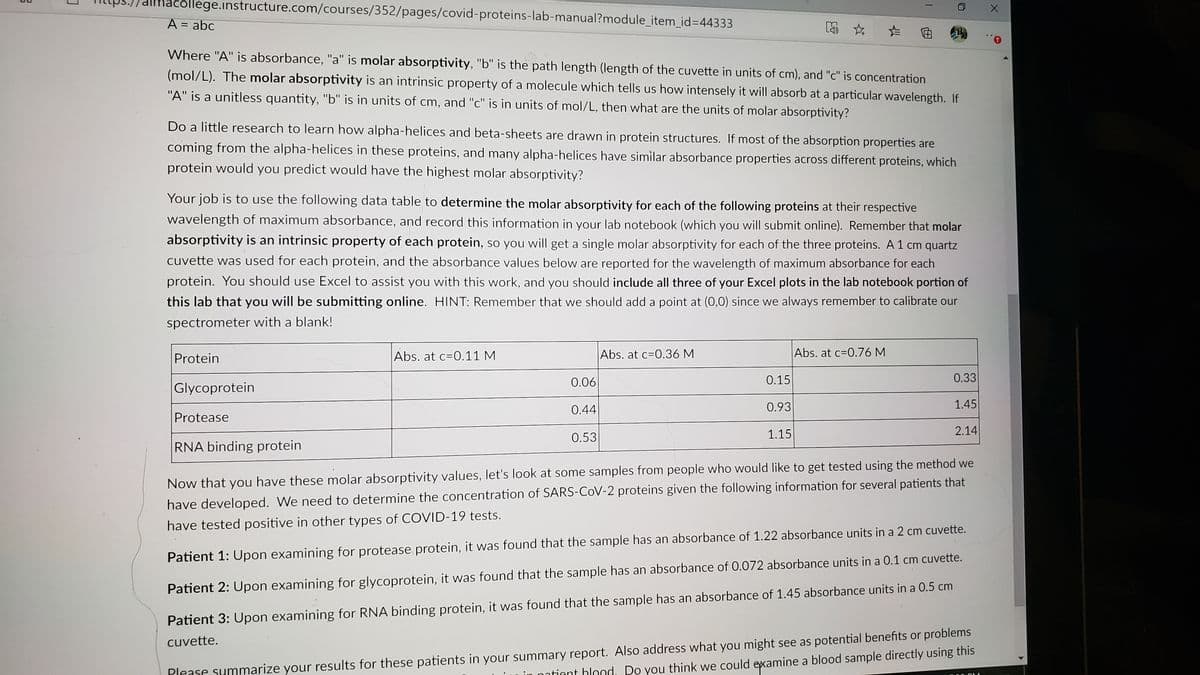1-proteins-lab-manual?module_item_id=44333 A= abc Where "A" is absorbance, "a" is molar absorptivity, "b" is the path length (length of the cuvette in units of cm), and "c" is concentration (mol/L). The molar absorptivity is an intrinsic property of a molecule which tells us how intensely it will absorb at a particular wavelength. If "A" is a unitless quantity, "b" is in units of cm, and "c" is in units of mol/L, then what are the units of molar absorptivity?
1-proteins-lab-manual?module_item_id=44333 A= abc Where "A" is absorbance, "a" is molar absorptivity, "b" is the path length (length of the cuvette in units of cm), and "c" is concentration (mol/L). The molar absorptivity is an intrinsic property of a molecule which tells us how intensely it will absorb at a particular wavelength. If "A" is a unitless quantity, "b" is in units of cm, and "c" is in units of mol/L, then what are the units of molar absorptivity?
Introduction to General, Organic and Biochemistry
11th Edition
ISBN:9781285869759
Author:Frederick A. Bettelheim, William H. Brown, Mary K. Campbell, Shawn O. Farrell, Omar Torres
Publisher:Frederick A. Bettelheim, William H. Brown, Mary K. Campbell, Shawn O. Farrell, Omar Torres
Chapter22: Proteins
Section: Chapter Questions
Problem 22.52P
Related questions
Question

Transcribed Image Text:macollege.instructure.com/courses/352/pages/covid-proteins-lab-manual?module_item_id=D44333
A = abc
Where "A" is absorbance, "a" is molar absorptivity, "b" is the path length (length of the cuvette in units of cm), and "c" is concentration
(mol/L). The molar absorptivity is an intrinsic property of a molecule which tells us how intensely it will absorb at a particular wavelength. If
"A" is a unitless quantity, "b" is in units of cm, and "c" is in units of mol/L, then what are the units of molar absorptivity?
Do a little research to learn how alpha-helices and beta-sheets are drawn in protein structures. If most of the absorption properties are
coming from the alpha-helices in these proteins, and many alpha-helices have similar absorbance properties across different proteins, which
protein would you predict would have the highest molar absorptivity?
Your job is to use the following data table to determine the molar absorptivity for each of the following proteins at their respective
wavelength of maximum absorbance, and record this information in your lab notebook (which you will submit online). Remember that molar
absorptivity is an intrinsic property of each protein, so you will get a single molar absorptivity for each of the three proteins. A 1 cm quartz
cuvette was used for each protein, and the absorbance values below are reported for the wavelength of maximum absorbance for each
protein. You should use Excel to assist you with this work, and you should include all three of your Excel plots in the lab notebook portion of
this lab that you will be submitting online. HINT: Remember that we should add a point at (0,0) since we always remember to calibrate our
spectrometer with a blank!
Protein
Abs. at c=0.11 M
Abs. at c=0.36 M
Abs. at c=0.76 M
0.06
0.15
0.33
Glycoprotein
0.44
0.93
1.45
Protease
1.15
2.14
0.53
RNA binding protein
Now that you have these molar absorptivity values, let's look at some samples from people who would like to get tested using the method we
have developed. We need to determine the concentration of SARS-Co\V-2 proteins given the following information for several patients that
have tested positive in other types of COVID-19 tests.
Patient 1: Upon examining for protease protein, it was found that the sample has an absorbance of 1.22 absorbance units in a 2 cm cuvette.
Patient 2: Upon examining for glycoprotein, it was found that the sample has an absorbance of 0.072 absorbance units in a 0.1 cm cuvette.
Patient 3: Upon examining for RNA binding protein, it was found that the sample has an absorbance of 1.45 absorbance units in a 0.5 cm
Please summarize your results for these patients in your summary report. Also address what you might see as potential benefits or problems
n natient hlond, Do you think we could examine a blood sample directly using this
cuvette.
Expert Solution
This question has been solved!
Explore an expertly crafted, step-by-step solution for a thorough understanding of key concepts.
This is a popular solution!
Trending now
This is a popular solution!
Step by step
Solved in 2 steps

Knowledge Booster
Learn more about
Need a deep-dive on the concept behind this application? Look no further. Learn more about this topic, chemistry and related others by exploring similar questions and additional content below.Recommended textbooks for you

Introduction to General, Organic and Biochemistry
Chemistry
ISBN:
9781285869759
Author:
Frederick A. Bettelheim, William H. Brown, Mary K. Campbell, Shawn O. Farrell, Omar Torres
Publisher:
Cengage Learning

Organic Chemistry
Chemistry
ISBN:
9781305580350
Author:
William H. Brown, Brent L. Iverson, Eric Anslyn, Christopher S. Foote
Publisher:
Cengage Learning


Introduction to General, Organic and Biochemistry
Chemistry
ISBN:
9781285869759
Author:
Frederick A. Bettelheim, William H. Brown, Mary K. Campbell, Shawn O. Farrell, Omar Torres
Publisher:
Cengage Learning

Organic Chemistry
Chemistry
ISBN:
9781305580350
Author:
William H. Brown, Brent L. Iverson, Eric Anslyn, Christopher S. Foote
Publisher:
Cengage Learning


Chemistry: Principles and Reactions
Chemistry
ISBN:
9781305079373
Author:
William L. Masterton, Cecile N. Hurley
Publisher:
Cengage Learning

World of Chemistry, 3rd edition
Chemistry
ISBN:
9781133109655
Author:
Steven S. Zumdahl, Susan L. Zumdahl, Donald J. DeCoste
Publisher:
Brooks / Cole / Cengage Learning